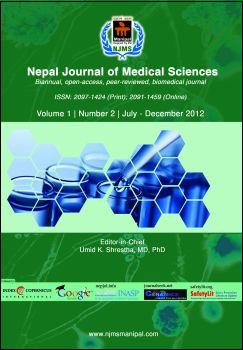Etiology and clinical profile of inpatients with Community acquired pneumonia in Manipal Teaching hospital, Pokhara, Nepal
DOI:
https://doi.org/10.3126/njms.v1i2.6605Keywords:
Community acquired pneumonia, etiology, Streptococcus pneumonia, vaccinesAbstract
Background: Community acquired pneumonia (CAP) is major cause of morbidity in adults. The presentation may be varied. Severity of the disease is seen to be more if co-morbid conditions are present, especially chronic lung disease. This study was done to analyze the etiology and clinical profile of community acquired pneumonia admitted in a tertiary hospital in Western Nepal, to focus on treatment options and improve outcomes.
Methods: Etiology and clinical profile of 100 patients of CAP was studied retrospectively from April 2010 to March 2011. Data regarding clinical features, physical examination, chest x-ray, sputum samples for smear microscopy and culture was collected in a preformed proforma and analyzed.
Results: Mean age of patients was 51 years. Forty one patients had associated co-morbidity. None of the patients were vaccinated against influenza and pneumococcus. The duration of hospital stay was longer in patients with higher CURB-65 score. The commonest mode of presentation was cough (76) followed by fever (64). Etiology was determined in 24 patients, commonest being Streptococcus pneumonia which was most commonly sensitive to penicillin group of antibiotics followed by cephalosporines. The mortality rate was 1%. Two patients required care in Intensive care unit and 97 were discharged after improving.
Conclusion: Etiology of pneumonia could be identified in 24% of cases. Pneumococcus was found mostly sensitive to penicillins and cepahalosporines. Gram negative organisms were mostly sensitive to ciprofloxacin and aminoglycoside. None of the patients were vaccinated against H.influenza or S.pneumoniae. Higher CURB-65 score was associated with longer duration of hospital stay.
DOI: http://dx.doi.org/10.3126/njms.v1i2.6605
Nepal Journal of Medical Sciences. 2012;1(2): 84-8
Downloads
Downloads
Published
How to Cite
Issue
Section
License
Copyright © by Nepal Journal of Medical Sciences. The ideas and opinions expressed by authors of articles summarized, quoted, or published in full text in this Journal represents only opinions of authors and do not necessarily reflect the official policy of Nepal Journal of Medical Sciences or the institute with which the author(s) is (are) affiliated, unless so specified.




